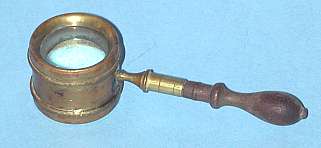
A Coddington lens
Sunday, December the 24th, 2006
back to: title, date or indexes
“Mesmerised a duck with a chalk line drawn from her beak sometimes level and sometimes forwards on a black table.” So wrote Gerard Manley Hopkins in his journal on 27 April 1871. I have long treasured this glimpse of the repressed Jesuit taking time out from various mortifications of the flesh to dally with a duck. Buried within his prose writings as it is, and thus by no means as well known as those magnificent poems, ‘Father Hopkins and his duck’ took on the air of a private pleasure for me, similar to that (illusory) sense of ‘ownership’ we feel for a favourite book, or piece of music, that hardly anyone else seems aware of.
So a few years ago, when I was reading an essay by Nicholson Baker—and I can't quite recall the piece, but it was probably in his collection The Size Of Thoughts—I reacted curiously when I came upon a line where he says, in passing, “Hopkins mentions somewhere mesmerising a duck”, or words to that effect. Part of me was pleased, wanting to give Mr Baker a conspiratorial wink, two chums sharing a snippet of private enjoyment. But I was vaguely irritated, too. How dare he go into print with Hopkins' duck before I publish my (never actually to be written) monograph?
Something similar has now happened with me and Thomas Pynchon. Eagerly gobbling up the highly enjoyable Against The Day, what is this I find on page 936? “Cyprian had been closely scanning the map with a Coddington lens.” Had he indeed? That would be the same Coddington lens which turns up from time to time in Hooting Yard, would it? Type “Coddington” into the Dobson search engine at the top of the page and you will find no less than four mentions of Coddington lenses within the archive. Now it would not surprise me if many readers think I just made it up, and it is true that there is a fifth mention (of a Coddington brush) which is spurious. But there are times when I know what I'm talking about.
The Coddington lens was invented by Henry Coddington in 1829. It is a single lens with two curved sides and a groove cut around the middle of the lens—the groove acting as a lens stop. It was (still is) a simple microscope handy for naturalists working in the field. I don't think there is a huge number of references to Coddington lenses in contemporary fiction, and I am quite happy to welcome Mr Pynchon to what I think of as my club. Intriguingly, twelve pages further on in Against The Day, on page 948 we find “Someplace between Plovdiv and Petrich, they disappeared.” Ah, Plovdiv! Devotees of my stories of Ugo, his blind ma, and his pal Ulf—about whom we have not heard for too many moons—will smile at the mention of that fair and fabled town, or city, whichever it might be.

A Coddington lens